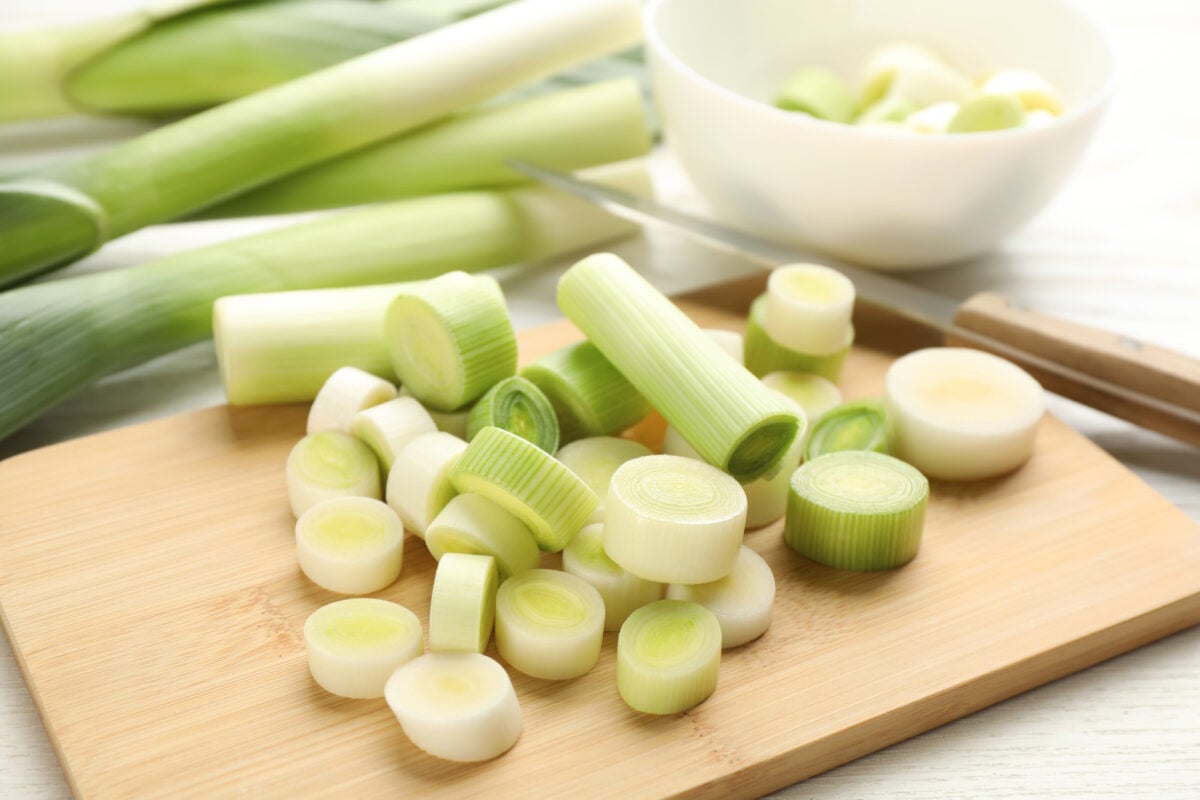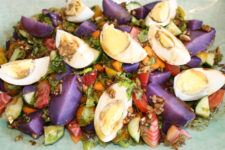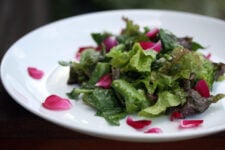Sunlight is a gardener’s best friend. At least, in most cases. But what about when sunlight makes vegetables fibrous, bitter, and less appealing, such as is the case with leeks?
That’s where blanching comes in. This process removes sunlight during growth to create a more appealing final veggie product. By blanching your leeks, you can grow plants with more of that tender, flavorful white stalk that is so useful in the kitchen.

Below, we’ll look at what blanching is, why your leeks need it, and how to blanch leeks using two very simple methods.
What Is Blanching?
As a passionate home chef, you probably know blanching as the process of submerging fruits and vegetables in boiling water and then quickly plunging them into a bath of ice water.
In the garden, though, blanching refers to an altogether different process of preparing fruits and vegetables for cooking.
In this case, blanching means restricting sunlight from hitting some or all parts of the plant in order to create areas of low chlorophyll.
Leaves, fruits, and stalks exposed to the sun tend to be more fibrous, have a more dramatic flavor, and, in the case of green parts, be bitter. By reducing chlorophyll content via blanching, you can often achieve more tender, subtly flavorful, less bitter veggies.
Blanching is often used when growing celery, artichokes, endive, and other notoriously tough or bitter greens. It’s also a very good tactic to use on leeks to get more white stalk than green stalk.

Why You Should Blanch Your Leeks
If you’ve worked with leeks in the kitchen, you already know that the most versatile and useful part of this spring vegetable is the white part of the stalk.
While the green stalk and leaves can add some much-needed sweet-spicy allium flavor to homemade stocks and broths, they’re often too tough and fibrous to use in other recipes. The white stalk, on the other hand, is tender and sweet, and packs just the right amount of onion flavor to use raw or cooked.
Leeks that you buy at the store have stalks that are almost entirely white. That’s because commercial growers always blanch their leeks.
To get the same useful product out of your garden, you have to blanch, as well. Luckily, this process is much easier than it sounds and doesn’t require a ton of time.
When to Start
Blanching restricts a plant’s ability to make food using photosynthesis, which means it can restrict growth. For this reason, it’s important to start blanching your leeks at the right time.
The typical rule of thumb is to begin blanching when the stalk of the leek is about as wide as a pencil. They typically reach this size between one to two months after germination.
Once you start the blanching process, continue until harvest.
Two Simple Ways to Blanch Leeks in the Garden
If you want to get creative, there are a ton of ways to blanch leeks. But the two easiest ways are to use dirt mounds or to install special collars to block the sun.
The Dirt Method
The dirt method is a cost-effective way to blanch leeks and takes less work in the beginning. However, it does require upkeep throughout the season and can lead to dirt getting in the leaves if you’re not careful.
Dirt in the leaves isn’t a terrible thing, but getting it out does require extra rinsing before the leeks can be used for cooking.

To blanch your leeks using dirt, follow these simple steps:
- Form a shallow trench and plant your leek seeds or seedlings in the bottom.
- Once the seedlings reach the size of a pencil, backfill the trench to cover the stems up to the first pair of leaves.
- Continue mounding dirt around the stalks as the leeks get taller, always stopping just below that first pair of live leaves.
The dirt will keep the sun off the stalks, which helps them stay white and tender. You can also try this method using straw or mulch. But be mindful that these lighter materials may blow off in heavy winds.
The Collar Method
One of the best ways to blanch leeks requires first rounding up some “collars.” Empty toilet paper tubes work incredibly well for this purpose. Small PVC pipes cut to size, rolled-up newspaper, and even tall paper cups with the bottoms cut out can also be used.

With this method, you have to do more work up front when the seedlings are small. But the collars should stay in place until harvest, which makes repeat work unnecessary. You also don’t have to worry about dirt getting in the leaves with this method.
To blanch your leeks using collars, follow these steps:
- Plant your leeks as normal.
- Once the stems are the size of a pencil, place the collar around each plant. Be sure to press the bottom of the collar into the soil a little to prevent it from blowing away.
- The leek will continue to grow with the leaves stretching out of the collar to reach the sun while the collar protects the stalk from sunlight.
In wet climates, I recommend using PVC pipe or thick cardboard tubes to prevent the collars from breaking down before harvest.
Using Leeks In the Kitchen
Once it’s time to harvest your leeks and bring them into the kitchen, you’ll be ecstatic you spent the extra energy blanching those stalks. Taking the time to do this will easily double, if not triple, the amount of tender white flesh you’ll get out of each plant.

So now the question is, what do you do with all those beautifully pale and tasty leek stalks?
Here are a few of my favorite leek recipes to inspire you:
- Roasted Garlic and Leek Soup – This soup combines 1 cup of leeks with garlic and sweet potatoes for a sweet and savory bowl of comfort.
- Florentine Pizza with Leeks – Delicious Os of tender leek stalk adorn this classic egg and fresh mozzarella Italian pizza.
- Braised Leeks with Pappardelle & Parmesan – It doesn’t get any better than braised leeks, and pairing them with thick pappardelle pasta and rich parmesan is the perfect way to elevate the flavor notes.
- Irish Oat Broth with Leeks and Dandelion Greens – This savory take on oatmeal comes straight out of Ireland and is a wonderfully healthy way to start any day.
- Savory Pumpkin & Leek Buckwheat Muffins – Get adventurous with these savory muffins packed with leeks, pumpkin, kale, and an array of tasty spices.






